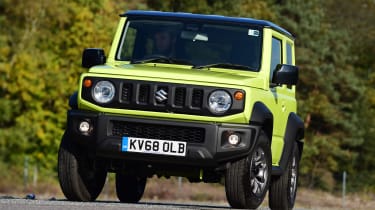Suzuki Jimny SUV - Engines, drive & performance (2018-2020)
The Suzuki Jimny is acceptable on-road and a very impressive performer off it
The Suzuki Jimny is quite unlike any other new car to drive, and it certainly won't suit everybody. Unlike most SUVs, the Jimny has a separate chassis onto which the bodywork is fitted, much like the SsangYong Korando and Land Rover Defender. It's a setup that lends itself to off-road ability but also leads to untidy handling on-road.
The first thing you'll notice is the steering, which feels very indirect and takes a lot of twirling from one lock to the other. That's ideal for off-road driving, where tiny course changes can be needed, but makes holding a straight line fairly tricky and parking a fairly laborious process.
If you judge the steering well enough to take a corner at speed, you'll probably not want to do it particularly often. The Jimny leans far more in corners than most other SUVs, yet doesn't compensate with a soft, comfortable ride. Instead, it's rather bouncy, and neither fun for the driver or relaxing for passengers.
As expected, the Jimny is in its element when you show it a muddy track. Push the levers to engage four-wheel drive and low-range gearing and the Jimny will seemingly tackle anything in its way. It's actually even more capable in the rough than its predecessor, thanks to clever electronics such as hill descent control and what Suzuki calls ‘Brake LSD Traction Control’.
Suzuki Jimny petrol engine
The latest Jimny is fitted with a four-cylinder 1.5-litre petrol engine, which replaces the smaller 1.3-litre engine used in the previous model. The newer, bigger engine produces 101bhp – a 14bhp increase. Acceleration has improved as a result, with 0-62mph taking around 12 instead of 14.1 seconds. While the additional power doesn't turn the Jimny into a quick car, it does make it more capable of keeping up with traffic than before. However, with 3,000rpm showing on the rev counter at 60mph, the Jimny is anything but a quiet cruiser.














